Menu
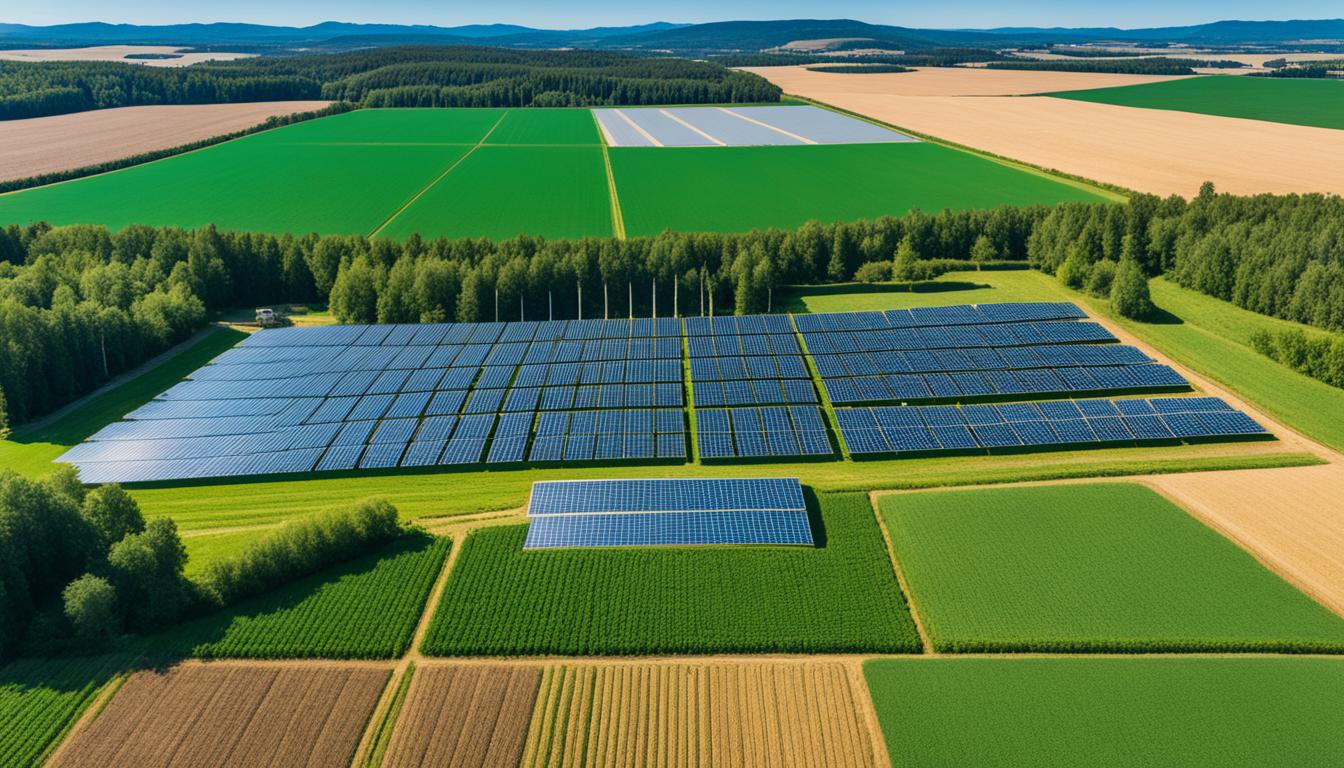
Did you know the global agri-food system causes 31% of human-caused greenhouse gases? This figure highlights the critical need for carbon footprint reduction farming. The agricultural sector must embrace climate-friendly farming to cut these emissions. As the world’s need for food is set to rise dramatically, we need smart and sustainable strategies to ensure food security and prosperity for future times.
Many efforts, like those by the United Nations, target zero greenhouse gases by 2050. They set big goals for 2030 too. Now, knowing and managing the carbon footprint in farming is crucial, not just a choice. It’s key for the health of our planet and the future of farming.
Studies show that businesses with low carbon footprints are more effective and resource-savvy. Tools such as Agrecalc help a lot. They can do accurate carbon audits for farms, showing where emissions come from. Practices like precision farming and the use of GPS and sensors to limit waste are key parts of sustainable agriculture.
Also, moving to renewable energy sources in farming can significantly lessen carbon emissions. This shows that adopting modern, eco-friendly farming methods is not only good for the planet but also for profits.
The carbon footprint in agriculture measures how much greenhouse gases farming emits. This greatly affects climate change. From growing crops to raising animals, many farm activities emit these gases. Therefore, it’s important to know and tackle these sources for sustainable food production.
Greenhouse gases like carbon dioxide (CO2), methane (CH4), and nitrous oxide (N2O) come from the agri-food system. This system makes up 31% of all human-made global emissions. A key method for lowering emissions is by using cover crops. They improve soil health and trap carbon, which cuts CO2 levels.
To lessen nitrous oxide, it’s vital to use nitrogen fertilizer less and at the right times. New tech, like drones that check nitrogen levels, makes applying fertilizers better. This promotes farming with fewer emissions, known as low-carbon agriculture.
Lowering farming’s carbon footprint is critical. It helps fight climate change and makes food production sustainable. By 2050, there will be a 56% rise in needed food. So, we must improve how we farm.
Methane from cows and from manure can be reduced by changing what the animals eat and by using anaerobic digesters. The use of biogas is debatable due to lower energy than natural gas. But, in places like California, strict rules on clean energy make it valuable.
Here’s data on how different farm practices reduce emissions:
| Strategy | Impact on Emissions | Notes |
|---|---|---|
| Cover Crops | Reduction in CO2 | Improves soil organic matter |
| Drone-based Fertiliser Application | Reduction in N2O | Increases precision in application |
| Feed Additives | Reduction in CH4 | Variety of additives under research |
| Anaerobic Digesters | Reduction in CH4 | Captures biogas from manure |
Research aims to create better fertilisers that reduce nutrient waste. This contributes to sustainable food production. A combined effort to cut down on greenhouse gases in farming is key for our food’s future and our environment.
Sustainable farming is now more important than ever. We need to lessen the impact agriculture has on the environment while ensuring we can feed everyone. Techniques such as eco-friendly farming and storing carbon in the soil are crucial. They help us keep a balance.
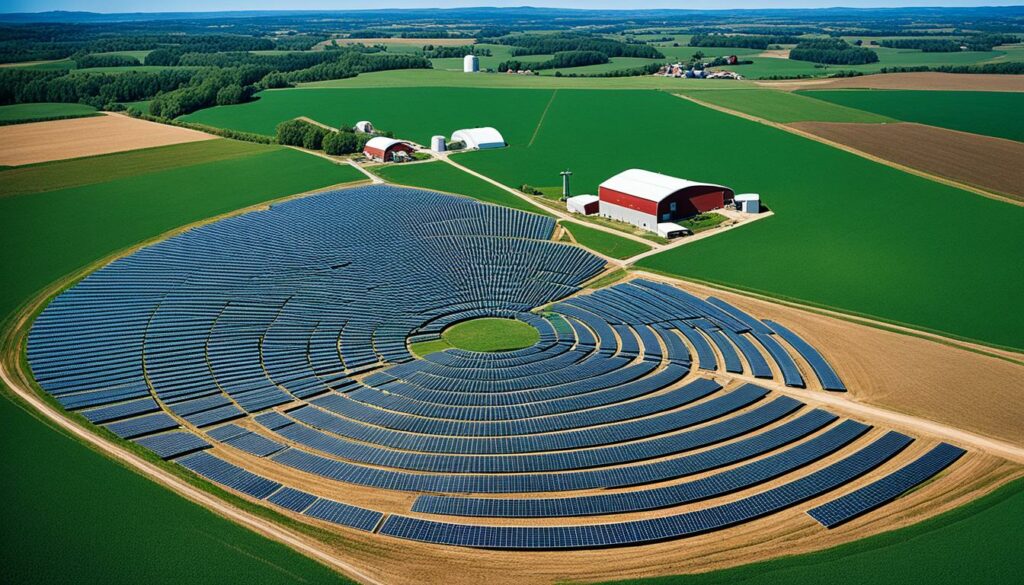
Eco-friendly farming helps the planet in many ways. It cuts down gas emissions, makes soil healthier, and supports wildlife. It stops over 40 million tonnes of CO2 from escaping into the air every year. Methods like storing carbon in soil are good for the climate. They take carbon out of the air.
Also, farming in ways that help the land recover improve how well it holds water. This means farmers might not need to use as many fertilisers. These ways of farming fight climate change. They also make sure the land stays good for growing food. We need these lands to produce more food as our population grows.
Using sustainable farming can be hard. It needs money at the start and you have to learn new things. You also have to give up some old ways of farming. But, these challenges are chances to think of new and better ways to farm.
The European Union says many soils are not in great shape – 60% of them to be exact. This shows we urgently need to manage our soils better. By doing things like measuring how much nitrogen the plants need, and planting different crops together, farmers can lower how much carbon they make. This also helps them handle changes in the weather better. It all works towards cutting down the world’s greenhouse gas emissions by 45% by 2030.
| Key Metrics | Statistics |
|---|---|
| Global greenhouse gas emissions from agri-food system | 31% |
| EU agricultural sector emissions | 11% |
| Livestock farming emissions contribution | Over 50% |
| Annual carbon loss from EU croplands and grasslands | 40 million tonnes |
| Projected increase in global food demand (2010-2050) | 56% |
Crop rotations are a key part of sustainable agriculture. They bring many benefits. This method uses different nutrients when you grow different crops. This makes farming more balanced and good for the environment.
Crop rotation boosts the number of different plants and tiny organisms in the soil. Each plant type has its own roots and substances that feed the soil’s ecosystem. This mix helps fight off disease and pests. It also cuts down the need for pesticides, keeping the environment in balance. For example, adding legumes to the plant cycle helps the soil hold more carbon. This reduces certain harmful emissions by 39% and improves overall greenhouse gas balance by 88%.
Rotating crops helps make the most of the soil’s nutrients. By changing crops, you stop the soil from losing its good elements. This keeps the soil strong. For instance, using legumes helps the soil’s carbon increase by 8%. This makes the soil healthier by 45%. It also makes crops like wheat and maize produce more.
| Benefits | Statistics |
|---|---|
| Reduction in Soil Depletion | Up to 45% improvement when legumes are part of diversified crop rotations |
| Decrease in Pesticide Use | Aids in disease and pest management by increasing plant and microorganism diversity |
| Carbon Sequestration | Significant impact when combined with no-till or low-till practices |
| Increased Yield | Equivalent yield boost of up to 38%, particularly in cereals |
| Enhanced Farmer Income | Potential to increase income by 20% through diversified cropping systems |
By rotating crops, we improve the soil health and fight climate change. This reduces harmful emissions and keeps more carbon in the ground. Increasing crop types in sustainable agriculture is vital for our farming future.
The 4Rs framework helps manage nutrients the best way. It’s all about the right time, rate, source, and place for fertilisers. This strategy improves how well fertilisers work and is kinder to the Earth.
Choosing when to apply nutrients is key. It boosts how much plants can use and cuts down on wasted nutrients. In places like Florida, using the best practices helps avoid water pollution from fertilisers.
Getting the amount of fertiliser right is crucial. It meets the needs of crops without putting too much. This helps keep the soil healthy and stops pollution. Plus, it can cut emissions that harm the planet.
Picking the best fertiliser and where to put it helps plants get what they need. This makes fertilisers work better and keeps the environment safe. Following science-based 4R plans is good for plants, the soil, and the planet.
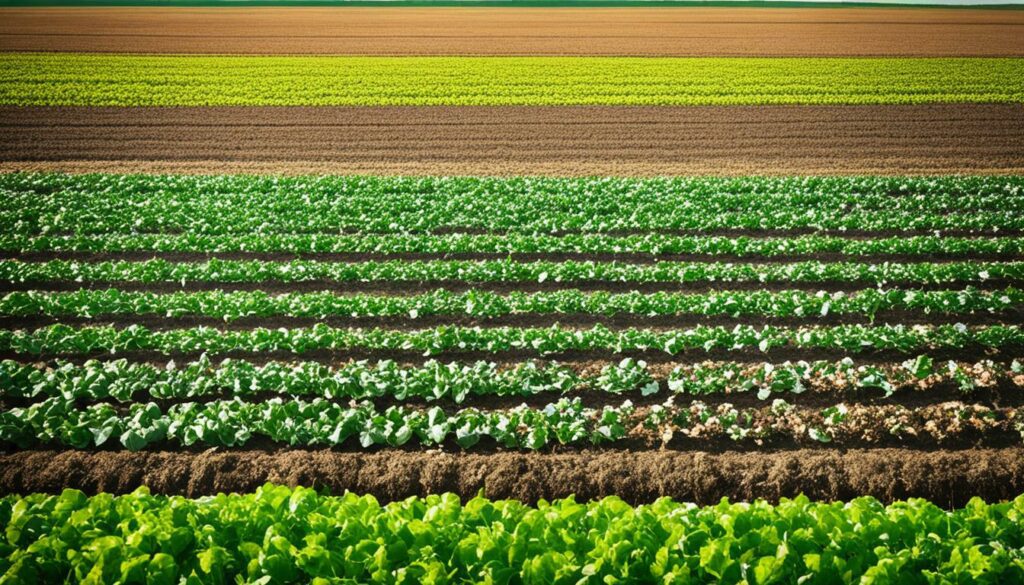
Focusing on effective fallow management is key to lessening agriculture’s environmental impact. Leaving land unplanted, called bare fallow, leads to soil quality reduction, higher erosion, and more fuel being used. This increases the carbon footprint and harms sustainable land practices.
Our food system causes about a third of all human-made greenhouse gases. So, stopping bare fallow practices is very important. As the need for food grows, every acre of land must be used wisely.
Almost 6% of farming’s emission comes from using fuel. Farmers can reduce this by not leaving fields bare and thus needing less fuel for soil preparation. Using renewable energy can also help, cutting both emissions and costs.
Implementing cover cropping is part of good fallow management. It can lower greenhouse gas emissions by storing carbon in the ground. Cover crops also increase soil quality, hold moisture better, and keep nutrients for plants.
Farmers who use cover crops spend less on fertilisers. This reduces their need for expensive fertiliser and makes water cleaner by preventing erosion. Often, more crops grow the first year of using cover crops. This shows it’s good for the environment and the farm’s productivity.
A key target is less greenhouse gas emissions by 45% by 2030. I think good fallow management and other green farming can help reach this. It’s crucial for a future with a stable climate.
Managing tillage is key to reduce soil erosion and enhance soil health. At Stanford University, a study showed a 3.3 percent boost in corn yields using conservation tillage. This proves using less intensive soil disturbance methods benefits farming.
Tillage can worsen soil erosion, causing the loss of topsoil. Adding more residue cover can cut soil erosion by 9.2 tons per acre. A wheat field in Minnesota, when tilled, released over 3,800 pounds of carbon dioxide. This shows how using traditional tillage affects the environment.
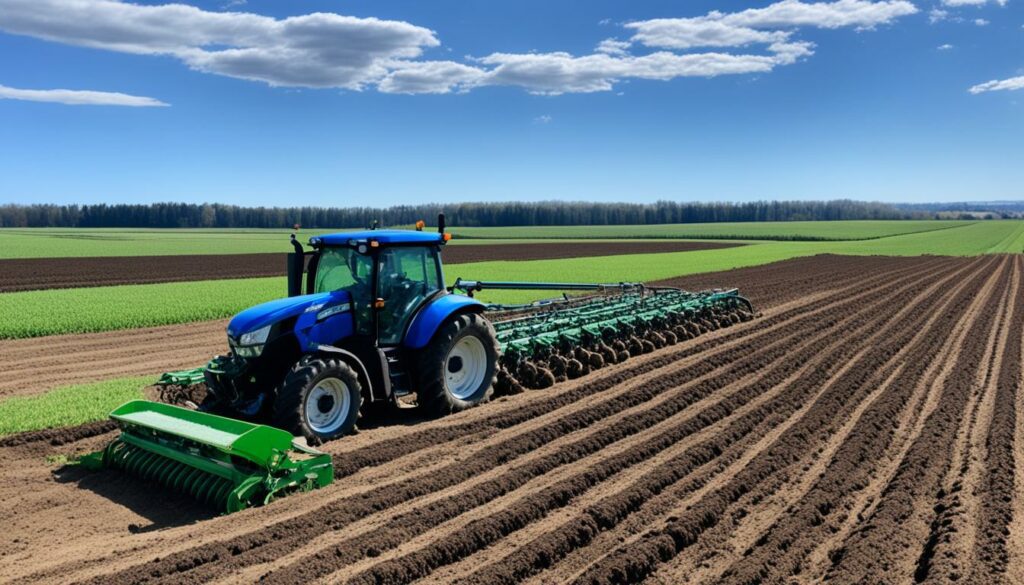
Reduced tillage helps keep soil moisture, improves water movement, and increases water-holding ability. No-till farming keeps soil lumps together, which is important for reducing erosion. By using conservation methods, farmers cut down on field trips, save on fuel, and lessen machine wear. This leads to more sustainable land use.
Since 2010-11, about 40 percent of corn, soybean, wheat, and cotton fields have used no-till or strip-till methods. This change shows people are recognising the benefits of these practices for both money and the environment. Farms in drought-prone areas often use EQIP contracts that encourage less tillage to improve soil’s stamina.
Choosing the right tillage can lessen weed growth, help with nutrient management, and better seeding of crops. This enhances soil health and increases carbon storage over time. For example, using no-tillage over ten years adds an average of 4.6 Mg/ha of carbon in the top soil, more than high tillage methods.
| Practice | Soil Erosion Reduction | Carbon Sequestration |
|---|---|---|
| No-Tillage (NT) | High | 4.6 Mg/ha over ≥ 10 years |
| Conservation Tillage (CT) | Moderate | Enhanced compared to High Tillage |
| High Tillage (HT) | Low | Baseline |
Adopting conservation tillage is crucial for sustainable agriculture. It helps with soil conservation, improves crop yields, and cuts down farming’s carbon footprint.
Being a leader in sustainable farming means understanding our main resource deeply. This is the soil. By testing soil regularly, we get insights into its health and nutrient levels. This knowledge helps us make better choices, improving how well crops grow and protecting the environment.
Monitoring soil health involves testing the soil’s characteristics like pH, organic matter, and microbes. These are key since crop growth depends on soil life. Tests also look at soil’s organic content and how tightly packed it is. This tells us about nutrients and if soil is too hard. For instance, CarbonNOW by Locus AG constantly checks these aspects to suggest the best soil care plans.
Understanding soil reports is key for good farming. These tests are done often to choose the right cover crops, how to rotate them, and what organic material to add. New methods like X-rays and neutron scans give us detailed 3D views without harming the soil. By using these advanced ways, we can improve soil health and work towards lessening our carbon footprint. The table below shows important soil test elements and how we measure them:
| Soil Characteristic | Importance | Measurement Technique |
|---|---|---|
| pH | Indicator of soil acidity/alkalinity | Standard pH Test |
| Organic Matter | Influences nutrient and water retention | Loss on Ignition |
| Microbial Activity | Essential for nutrient cycling | Bioindicator Assays |
| Bulk Density | Measures soil compaction | Dry Weight to Volume Ratio |
| SOC | Crucial for soil fertility | Chemical Analysis |
| Ammonium Levels | Indicative of fertiliser need | Sensor-based Measurement |
Keeping up with soil testing and health monitoring is vital. They help crops grow better and cut down on harmful carbon from farm operations.
Cover crops are now known for their many benefits to farming. They help improve the soil, clean water, and fight climate change. These crops capture carbon and reduce harmful gases. So, farmers can grow better crops without harming the planet.
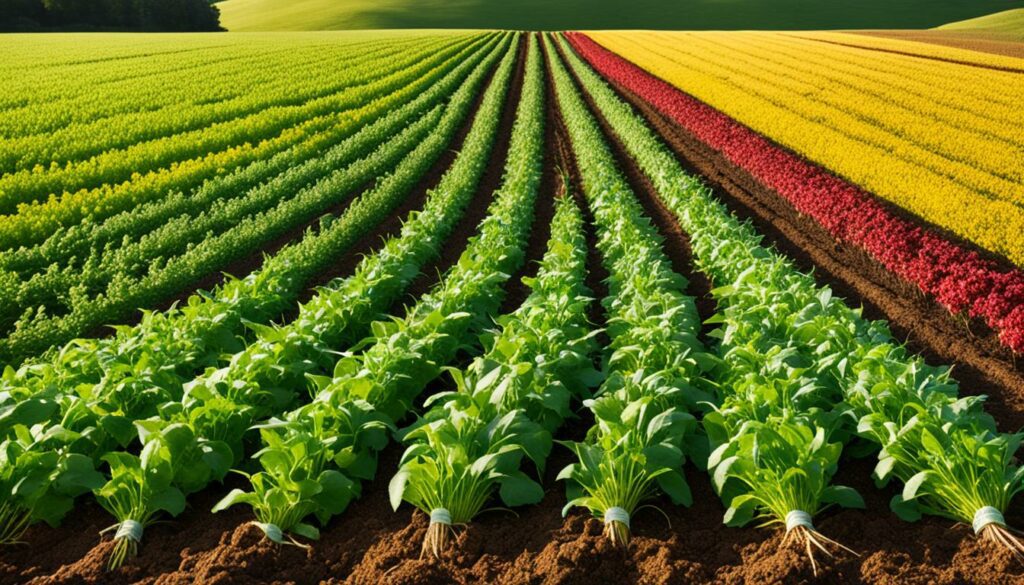
Cover crops boost the amount of organic matter in the soil. This makes the soil better at holding nutrients. It also traps carbon, cutting down on greenhouse gases. Plus, cover crops make sure the soil is rich for future plants, helping farms stay healthy over time.
Cover crops also stop the soil from washing or blowing away. They cover the ground, stopping rain and wind from damaging it. This keeps water clean and the land fertile. So, they’re crucial for maintaining good soil and water for farming.
Cover crops help control weeds and pests naturally. This makes farms safer for the environment and it can save money. Though starting with cover crops cost more, they reduce the need for fertilisers. This, along with better crops, makes it worth the investment in the long run.
Cover cropping can reduce 10% of agricultural greenhouse gas emissions, substantially aiding in climate change mitigation within the agricultural sector.
Therefore, cover crops are key to healthy soil and a greener agricultural future.
Managing manure well is key to keeping soil healthy and cutting down on farm pollution. By changing when and how much manure we use, we can lower the risk of losing nutrients and creating harmful gases. Now, let’s look at some important ways to handle manure wisely.
We use a plan called the 4Rs to manage manure right. It means using the right amount at the right time, choosing the right type, and putting it in the right place. By being careful, we help crops use the nutrients better and stop waste. This also fits with good farm practices, helping to lower harmful gas production.
Using liquid manure for cows and pigs can create a lot of harmful gases. But, using special systems can cut down on these gases by catching and burning them. For example, in Rwanda, a system called Flexibiogas shows how efficient systems can be. It uses less manure but produces the same biogas.
In places like Asia and Europe, where lots of these harmful gases come from, it’s important to use such technology. Another benefit is that using better systems can cut methane, a gas that’s very bad for the planet, by 90%. Spreading manure over fields every day, using pastures well, and turning it into compost all help, too. Because methane is much worse for the Earth than carbon dioxide, managing manure right is very important.
| Region | Emission Percentage | Dominating Systems | Reduction Technique |
|---|---|---|---|
| Asia | 43% | Liquid-based | Biogas Systems |
| Europe | 27% | Liquid-based | Anaerobic Digestion |
| Other regions | 30% | Mixed | Daily Spreading, Pasture-based Systems |
By using the best manure methods, farms can help the Earth a lot. They cut down on bad gases, make soil better, and increase farm productivity. This is good for the planet and for farms.
The world needs to find ways to reduce greenhouse gas emissions. The agricultural sector is a big part of this, causing about 31% of such emissions. Many of these come from the fuel used on farms. With global food demand set to soar by 56% from 2010 to 2050, switching to sustainable practices is crucial.
One key step is investing in renewable energy and efficient farming gear. Doing this can lower the carbon footprint of agriculture.
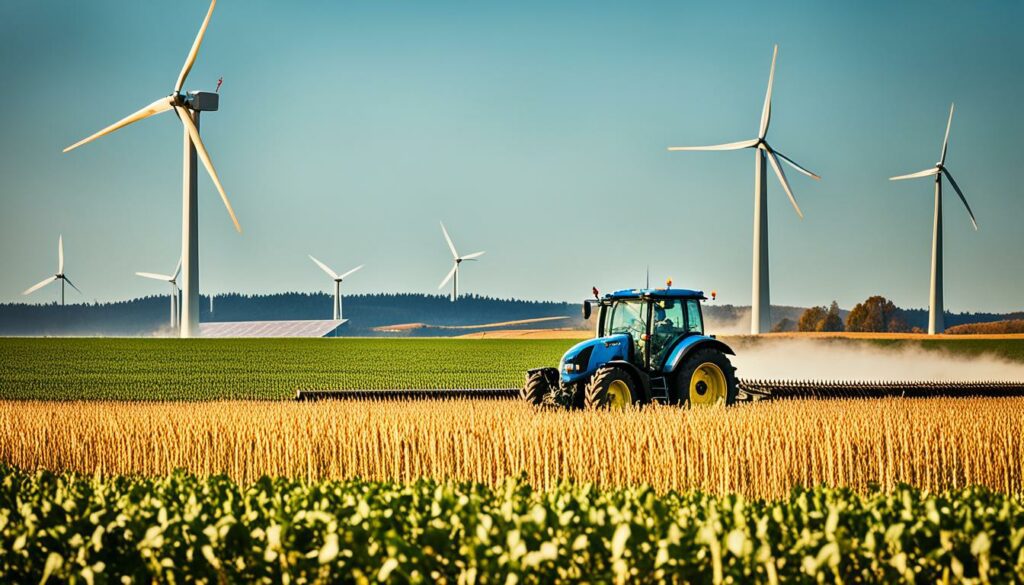
Solar power helps farmers cut down on electricity bills. It’s a great way to save money in the long run. Wind power is also becoming more popular. Wind turbines turn wind’s energy into electricity, which can be used or sold. Biofuels that come from plants, like biodiesel and ethanol, are great alternatives to fossil fuels. They help our planet by using resources that can be renewed.
Programmes like the Rural Energy for America Program (REAP) support farmers in making this shift. REAP can even pay for half the costs, sometimes up to 75%. There’s also the Investment Tax Credit (ITC), which lets farmers lower their taxes by up to 30% on solar system installations.
It’s time for agriculture to upgrade to better, energy-saving machines. About 6% of the sector’s emissions come from using fuel. To help, there are state-level programmes and grants available. These include the Agriculture Energy Efficiency Rebate program and the Small Business Advantage Grant, which assist in funding energy-saving projects. The Environmental Quality Incentives Program (EQIP) On-Farm Energy Initiative aids farmers in buying energy-efficient equipment after an audit shows they need it.
| Program | Cover Percentage | Funding Range |
|---|---|---|
| REAP Grants | 50% (combined up to 75%) | $2,500 – $1 million |
| Energy Efficiency Grants | 50% or 25% | $1,500 – $500,000 |
| Investment Tax Credit (ITC) | Up to 30% | Varies by project |
Choosing renewable energy and energy-efficient farming equipment is good for the earth. It’s also smart for farming businesses. Through support from national and state governments, farmers can cut their greenhouse gas emissions. They can do this while keeping their farms successful and sustainable.
Fertilisers play a vital role in agriculture’s sustainability. They boost crop yields and keep soil nutrients at good levels. As the need for food increases, technology in fertilisers is more important. Innovations like controlled release and fertigation help spread nutrients better. This reduces harm to the environment.
Research from the FAO shows agriculture causes 31% of all human-made greenhouse gases. New fertilisers are tackling this problem by using nutrients more effectively. For example, ICL is developing fertilisers that help crops absorb more nitrogen and phosphorus, key for big yields.
By using AgTech, farmers can manage nutrients more precisely. This means less waste and fewer emissions, helping the environment. Adding both organic and synthetic fertilisers improves soil health. It’s a win-win for the planet and for farming efficiency.
Fuel on farms is a big source of emissions, making up 6% of the total. Using new technologies and ways to make fertilisers can cut these emissions. For example, water electrolysis can reduce a lot of methane, helping to lower agriculture’s carbon impact.
| Nutrient Management | Impact on Crop Yields |
|---|---|
| Controlled Release Fertilisers (CRF) | Enhances nutrient availability, reduces application rates |
| Fertigation Methods | Provides precise nutrient delivery to crops |
| Organic Fertilisers (Manure, Compost) | Improves soil structure, nutrient content |
These methods boost harvests and fight climate change. ICL’s CRF technology lets farmers grow more with less fertiliser. This leads to a greener, more sustainable agriculture.
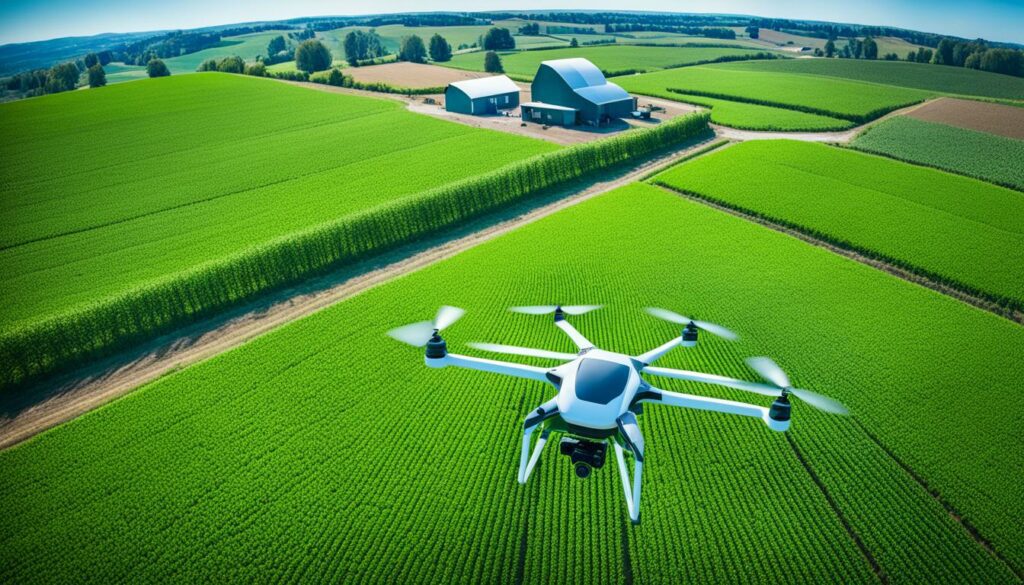
With the world facing a big spike in greenhouse gas emissions, we need new ways to fight climate change. One key method is data-driven farming, which uses Artificial Intelligence and smart sensors in agriculture. This approach helps farmers improve their methods and make smarter choices.
Data-driven systems in precision agriculture have many upsides. They can reduce waste by using resources better, says studies. This is crucial as GHG emissions soared from 21GtCO2-eq in 2010 to nearly 59GtCO2-eq in 2019. Managing inputs with data is also key to meeting our sustainability aims.
Using Artificial Intelligence and smart sensors in agriculture is changing the game. These tools check farm conditions in real time, helping farmers adjust quickly. For instance, they can monitor soil moisture to save water. Plus, AI can forecast the best times to plant or harvest, cutting emissions and supporting sustainability.
By using data in farming, we could cut GHG emissions from livestock by as much as 30%. This shows just how powerful technology can be in making agriculture greener.
With tools like the Cool Farm Tool and AgRECalc, farmers are equipped to precisely estimate and manage their emissions, ensuring that today’s practices do not compromise tomorrow’s environment.
Carbon footprint reduction farming is vital for today’s agriculture. It combines high productivity with care for the environment. This method helps tackle the large share of global greenhouse gas emissions from agriculture, now at 31%.
Sustainable farming is key because we expect a 56% increase in food demand by 2050. Innovative farming methods are needed. We aim to lower greenhouse gas emissions by 45% by 2030 to keep global warming under 1.5 degrees Celsius.
Farming is using many strategies to reduce its carbon footprint. For instance, there are new fertilisers with biodegradable coatings and slow-release granules. These developments, like those from ICL, help save nutrients and support the European Green Deal goals.
Reducing methane from livestock and capturing it from manure are important methods. Also, by testing plant tissues and soils, farms can apply fertilisers more accurately. They’re also using advanced fertilisers to cut down on nitrogen without losing crop yields.
Bettering fuel use on farms and adopting no-till farming can help. These steps target the 6% of emissions from production that come from using fuel. Practices like conservation tillage and adding organic material also help store carbon in the soil.
Generating renewable energy on farms is a smart choice for reducing emissions. This all-rounded method makes carbon footprint reduction farming effective. It doesn’t just reduce harm to the environment. It creates a clearer and stronger future for agriculture.
We’re moving towards sustainable farming with the help of advanced AgTech solutions. These new techs make farming more efficient and less harmful to our planet. They change not only how we farm but also make us farm more wisely with nature in mind.
The agriculture world is seeing lots of new and amazing technologies. A recent survey on LinkedIn showed that Farm Automation Tech and Precision Agriculture are making big impacts. Genetically modified crops are a key player, offering more food, fighting off pests, and using land better.
Aquaponics and aeroponics are also becoming popular for saving water and space, perfect for city farming.
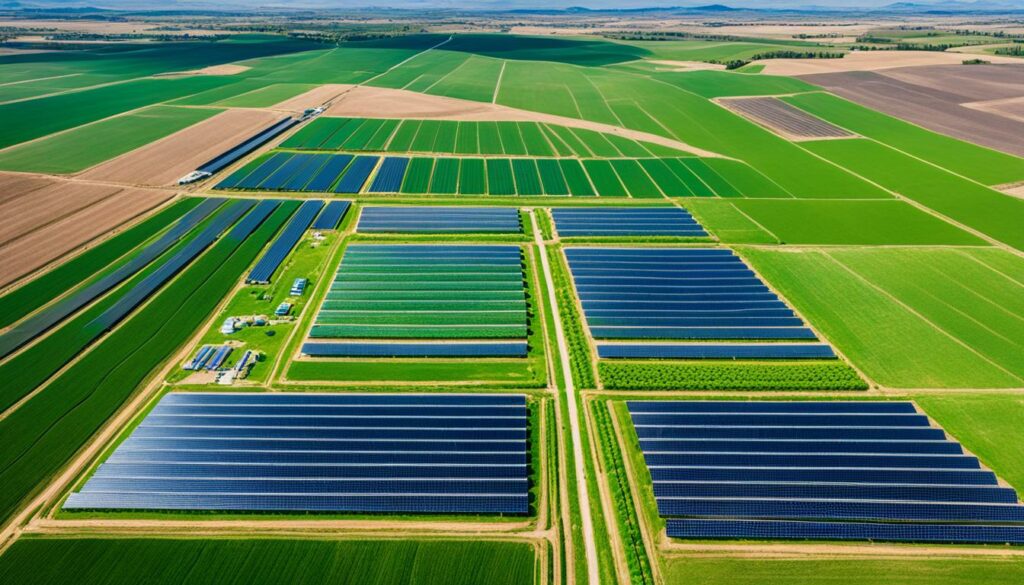
Smart farming brings together IoT, sensors, big data, drones, AI, and more. It makes farming more exact and saves resources. Thanks to these technologies, farming decisions are now based on data, not guesswork. This is boosting harvests and helping the planet.
AgTech is boosting what we get from crops, making them better and more. CubicFarms, for example, creates big machines for growing food and animal feed. Their tech saves water and cuts out harmful chemicals. Meanwhile, Babylon is into indoor farming that uses less water and fertilisers, making a big cut in pollution.
MyEasyFarm’s platform keeps a watch on crops and how they’re treated, aiming for a Low Carbon Label. Then there’s FlyFarm, growing insects to recycle food waste. Also, Volta Greentech has something new – a feed for cows that cuts down on their methane gas a lot.
These stories show the fantastic journey of agriculture towards green tech. Using automation, precision farming, and smart methods, we aim for a better farm future that doesn’t harm the Earth.
Looking back on the journey to tackle climate change in farming is key. It shows that the future of farming depends on using sustainable methods. In the USA, farming has often led to a lot of CO2 pollution.
This pollution comes from things like managing soil, how animals digest food, and dealing with their waste. But today, we want to blend these necessary tasks with earth-friendly ways. We aim to keep farming going in a way that’s good for the planet.
Most of the pollution in farming happens when we burn fossil fuels. Using renewable energy and better farm machines can really help. For farms with animals, finding new types of food and ways to handle their waste can cut down their harmful gases.
Doing things like planting without turning the soil and using nutrients wisely cuts CO2. It also helps the earth by locking up more carbon in the ground. Farmers can make extra money by joining programs that pay for lowering pollution.
There are also laws that encourage making clean energy from farm products. Using new kinds of fertilisers helps too. The UN wants us to cut worldwide greenhouse gases by 45% by 2030. So, what we do now is very important.
In ending, making farming more sustainable is vital for its future. By working together and being creative, we can lower farming’s impact on the climate. This journey is not just about protecting nature. It’s also about creating a lasting and healthy world for those that follow us.
Carbon footprint reduction farming is all about cutting down the gases agriculture makes. It uses techniques like better farming methods, changing crops, cleaner energy, and smarter ways to handle nutrients. These steps aim to make farming more eco-friendly.
Lowering the carbon footprint helps fight climate change, keeps soil healthy, and ensures there’s enough food in the future. Since farming produces a lot of greenhouse gases, changing to greener methods is key to a better environment by 2050.
There are lots of ways farmers are cutting carbon. These include planting different crops every year, covering the soil between crops, using less soil turning, being smarter with nutrients, and using clean energy. All this helps store carbon, reduce bad gases, and keep the soil strong.
Swapping crops every year makes the soil richer and helps fight off disease in plants. It also makes sure the soil gets all the nutrients it needs. These things together help keep the soil healthy and lower carbon footprints.
The 4Rs way of feeding plants means putting the right food, in the right amounts, at the right time, and in the right place. This makes sure plants get only what they need. It stops waste and pollution, making farming more sustainable.
Leaving fields bare harms the soil, makes it easier for dirt to wash away, and adds to air pollution. Choosing better ways to manage land keeps the soil healthy and cuts down on harm to the environment.
Looking after how we turn the soil, like by not doing it as much, means the soil stays in good shape and doesn’t wash away. Using the land carefully saves energy and helps lower the gases that heat up our planet.
Crops planted just to protect the soil make it better, keep nutrients in place, and stop the soil from getting washed away. This makes the soil healthier and traps carbon, helping the planet.
Handling animal waste the right way stops it from polluting water and air, and lowers greenhouse gases. This is another way farmers can cut down on their carbon output.
Using wind, sun, and other clean powers means farmers don’t need as much polluting fuel. It’s also good for the bottom line, saving money on energy while helping the environment.
Fertilisers help crops grow and keep the soil well. New types of fertiliser are better for the planet because they’re not wasted. They play a big part in greener farming.
Smart tech like sensors and machines that think can make farming work better and save resources. This smarter way to farm is good for cutting carbon and looking after the land we need.
New tech in agriculture makes things run smoother, help the planet, and make better crops. By using things like AI, farming is more effective and friendlier to the environment.